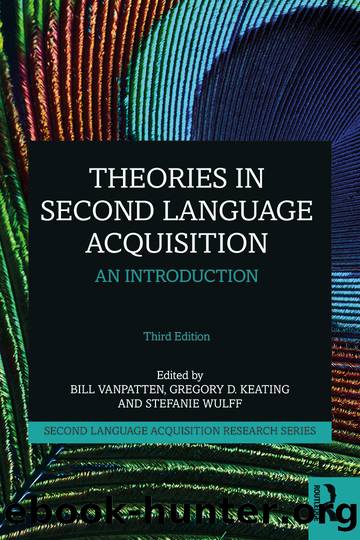Theories in Second Language Acquisition by Bill VanPatten;Gregory D. Keating;Stefanie Wulff; & Gregory D. Keating & Stefanie Wulff

Author:Bill VanPatten;Gregory D. Keating;Stefanie Wulff; & Gregory D. Keating & Stefanie Wulff
Language: eng
Format: epub
Publisher: Taylor & Francis Ltd
Published: 2020-04-15T00:00:00+00:00
Common Misunderstandings
Here I address two common misunderstandings about the DP model and also discuss how this model differs from other neurocognitive perspectives of L2. I will discuss the various misunderstandings regarding the relation between the declarative and procedural memory systems on the one hand, and explicit and implicit knowledge on the other, in the section âThe Explicit/Implicit Debate.â
First, there is a common misunderstanding regarding the domain generality of the two memory systems. On the one hand, both systems are âdomain generalâ in that they underlie multiple cognitive domains. However, this does not preclude sub-specialization for language within either system, which could come about either evolutionarily or during learning and development. Indeed, evidence from other domains suggests that sub-specialization can occur in both systems. For example, different portions of the MTL and different regions of temporal neocortex underlie different types of information (Ullman, 2016). Likewise, different frontal/basal ganglia circuits subserve different sorts of information (Middleton & Strick, 2000). Nevertheless, at this time there is no convincing evidence for domain-specific circuitry for language (i.e., circuitry dedicated exclusively to language), either within structures involved in the two memory systems or elsewhere in the brain (Ullman, Lum, & Conti-Ramsden, 2014). Future research may further clarify this issue.
Second, a common misconception is that the changes in the reliance of grammar from declarative to procedural memory are due to some sort of âtransformationâ of knowledge from one to the other system. This is not the case. Rather, the two systems seem to acquire knowledge largely independently from each other (apart from interactions such as competition between the systems, as described above). Indeed, amnesic patients such as H.M. can acquire skills in procedural memory without ever having learned such skills in declarative memory (such dissociations were in fact the basis of the discovery of multiple memory systems). Thus, the proceduralization of grammar does not constitute the âtransformationâ of declarative into procedural representations but rather the gradual acquisition of grammatical knowledge in procedural memory, which is increasingly relied on, with an accompanying decrease in reliance on any analogous grammatical knowledge that was learned in declarative memory.
Finally, to clarify any potential misconceptions regarding differences between the DP model and other neurocognitive models of L2, here I will compare the models. The DP model lies within one of three broad classes of neurocognitive models of L2. One class of models posits that the neurocognitive mechanisms underlying L2 are essentially the same as those subserving L1 (Abutalebi, 2008; Ellis, 2005; Green, 2003; Hernandez, Li, & MacWhinney, 2005; Indefrey, 2006; MacWhinney, 2011). Second, it has been suggested that the mechanisms underlying L2 are fundamentally different from those underlying L1 (Bley-Vroman, 1989). A third group of models hypothesizes that L2 learners initially depend heavily on different substrates than L1, but, with increasing experience or proficiency, gradually rely more on L1-like neurocognitive mechanisms. This group of theories includes the views espoused by Paradis and Clahsen, as well as the DP model. Although these views are similar in certain respects, they also differ.
Here I summarize the perspectives taken by Paradis and Clahsen, in the context of the DP model.
Download
This site does not store any files on its server. We only index and link to content provided by other sites. Please contact the content providers to delete copyright contents if any and email us, we'll remove relevant links or contents immediately.
The European History Highway: A Guide to Internet Resources by Dennis A. Trinkle Scott A. Merriman(492)
The Seven Wonders of the Ancient World by Michael Denis Higgins(476)
European Security without the Soviet Union by Stuart Croft Phil Williams(468)
European Security in a Global Context by Thierry Tardy(467)
The Routledge companion to Christian ethics by D. Stephen Long Rebekah L. Miles(457)
Hudud Al-'Alam 'The Regions of the World' - a Persian Geography 372 A.H. (982 AD) by V. V. Minorsky & C. E. Bosworth(398)
Gorbachev And His Generals by William C. Green(390)
Get Real with Storytime by Julie Dietzel-Glair & Marianne Crandall Follis(388)
Tibetan Studies in Comparative Perspective by Chih-yu Shih Yu-Wen Chen(385)
Governance, Growth and Global Leadership by Espen Moe(380)
Hyperculture by Byung-Chul Han(374)
CliffsNotes on Fitzgerald's The Great Gatsby by Kate Maurer(359)
The Oxford History of the World by Fernández-Armesto Felipe;(353)
How Languages Are Learned 5th Edition by Patsy M Lightbown;Nina Spada; & Nina Spada(352)
The Egyptian Economy, 1952-2000 by Khalid Ikram(349)
Oral Poetry and Narratives from Central Arabia: The Poetry of Ad-Dindan : A Bedouin Bard in Southern Najd (Studies in Arabic Literature, Vol 17) (English and Arabic Edition) by P. M. Kupershoek P. Marcel Kurpershoek(341)
The Oxford Handbook of the Incas by Sonia Alconini(333)
Europe Contested by Harold James(319)
The Hutchinson Dictionary of Ancient and Medieval Warfare by Peter Connolly John Gillingham John Lazenby(304)
